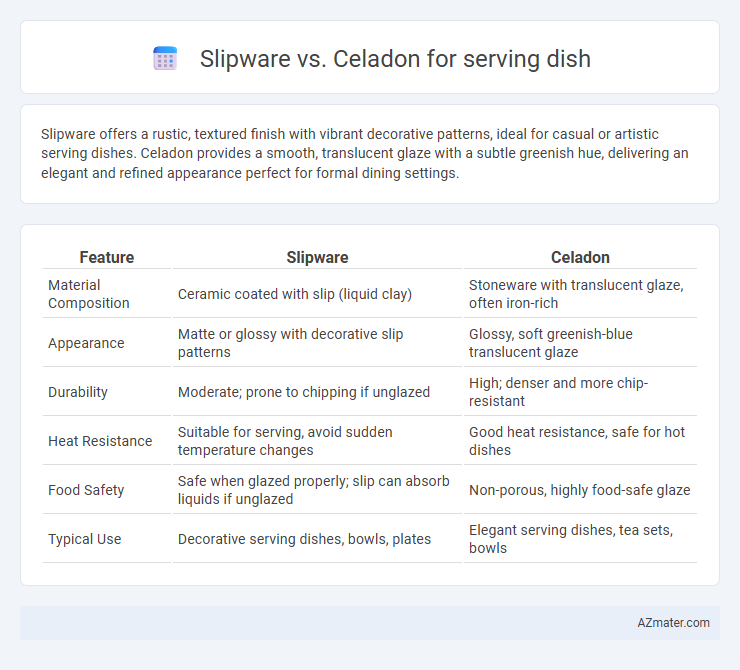Slipware offers a rustic, textured finish with vibrant decorative patterns, ideal for casual or artistic serving dishes. Celadon provides a smooth, translucent glaze with a subtle greenish hue, delivering an elegant and refined appearance perfect for formal dining settings.
Table of Comparison
| Feature | Slipware | Celadon |
|---|---|---|
| Material Composition | Ceramic coated with slip (liquid clay) | Stoneware with translucent glaze, often iron-rich |
| Appearance | Matte or glossy with decorative slip patterns | Glossy, soft greenish-blue translucent glaze |
| Durability | Moderate; prone to chipping if unglazed | High; denser and more chip-resistant |
| Heat Resistance | Suitable for serving, avoid sudden temperature changes | Good heat resistance, safe for hot dishes |
| Food Safety | Safe when glazed properly; slip can absorb liquids if unglazed | Non-porous, highly food-safe glaze |
| Typical Use | Decorative serving dishes, bowls, plates | Elegant serving dishes, tea sets, bowls |
Introduction to Slipware and Celadon
Slipware features a decorative technique using liquid clay slip to create vibrant patterns and textures on ceramic surfaces, offering a tactile and rustic appeal ideal for serving dishes. Celadon is renowned for its translucent glaze with subtle green or blue hues, originating from ancient Chinese pottery traditions, providing an elegant and smooth finish perfect for sophisticated tableware. Both styles enhance serving dishes with unique aesthetic qualities and historical significance, catering to diverse dining experiences.
Historical Background of Slipware
Slipware, characterized by its decorative use of liquid clay slip, traces its origins to ancient civilizations such as those in Mesopotamia and China, dating back over 3,000 years. This technique flourished in medieval Europe and East Asia, where artisans applied contrasting slips for intricate patterns, making slipware highly valued for both functional and ornamental serving dishes. Unlike celadon, which is known for its translucent green glaze originating from Song Dynasty China, slipware's historical appeal lies in its vivid surface designs and textural contrasts achieved through slip application.
Origins and Development of Celadon
Celadon originated in the Tang Dynasty of China, gaining prominence during the Song Dynasty for its jade-like glaze and refined aesthetic. Slipware, characterized by its slip decoration technique, developed primarily in Europe and the Middle East with a focus on texture and color contrast. Celadon's distinctive translucent glaze evolved through sophisticated firing methods, setting it apart as a high-quality serving dish prized for its elegance and durability.
Crafting Techniques: Slipware vs Celadon
Slipware features a decorative technique where slip, a liquid clay mixture, is applied to the surface before firing, creating bold patterns and textures with contrasting colors. Celadon pottery is characterized by its translucent glaze, achieved through an iron oxide glaze fired in a reduction kiln, producing subtle green or blue hues with a smooth, glass-like finish. Both techniques demand precision but differ significantly: Slipware emphasizes painted or trailed designs on opaque surfaces, while Celadon highlights glaze depth and clarity on refined stoneware.
Visual Characteristics and Aesthetics
Slipware features bold, contrasting patterns created by applying liquid clay slips on the surface, resulting in a rustic, textured appearance with earthy tones and decorative motifs. Celadon is distinguished by its smooth, glassy glaze with subtle, translucent green or blue hues that highlight fine details beneath the surface, offering an elegant and refined look. The visual appeal of slipware emphasizes artisanal craftsmanship and organic textures, while celadon exudes a serene, sophisticated aesthetic ideal for minimalist or traditional serving ware.
Durability and Practicality for Serving Dishes
Slipware features a robust, thick slip coating that enhances chip resistance and makes it highly durable for everyday serving use. Celadon, known for its translucent glaze and delicate appearance, tends to be more susceptible to scratching and thermal shock but offers a smooth, non-porous surface ideal for preserving food flavors. In terms of practicality, slipware's textured finish provides better grip and impact resilience, while celadon's elegant finish suits formal presentations but requires careful handling.
Cultural Significance and Symbolism
Slipware, notable for its rich, decorative patterns created by applying liquid clay slips, embodies a deep cultural heritage linked to folk art traditions across Europe and Asia, symbolizing craftsmanship and everyday utility. Celadon, recognized for its translucent, jade-like glaze rooted in ancient Chinese dynasties, carries profound symbolism of purity, elegance, and status, often associated with spiritual and philosophical ideals in East Asian cultures. Choosing between slipware and celadon for serving dishes reflects a preference for either artisanal storytelling through bold motifs or sophisticated minimalism infused with historical prestige.
Maintenance and Care Tips
Slipware serving dishes require gentle hand washing with mild soap to preserve their decorative slip glaze and prevent chipping, avoiding abrasive scrubbers. Celadon serving dishes benefit from careful handling to maintain their smooth, translucent glaze and should be cleaned with a soft cloth or sponge in warm water, as dishwashers can dull the finish. Both materials thrive with thorough drying after washing to prevent moisture damage and enhance long-term durability.
Popular Uses in Modern Dining
Slipware features a tactile, rustic aesthetic favored for casual, artisanal serving dishes in modern dining, often used for appetizers and rustic bread bowls. Celadon, known for its translucent glaze and subtle green-blue hues, is popular for elegant presentations such as sushi platters and fine dining settings. Both types enhance the dining experience by combining functionality with distinctive visual appeal tailored to their service style.
Choosing the Best for Your Table: Slipware or Celadon
Slipware offers a rustic charm with its hand-decorated, earthy glazes that create a warm and inviting atmosphere, ideal for casual or traditional table settings. Celadon features a smooth, translucent glaze with subtle greenish hues, providing an elegant and refined look perfect for formal or minimalist dining environments. When choosing the best serving dish, consider slipware for its artisanal texture and vibrant patterns, while celadon suits those seeking timeless sophistication and understated beauty.

Infographic: Slipware vs Celadon for Serving dish
 azmater.com
azmater.com